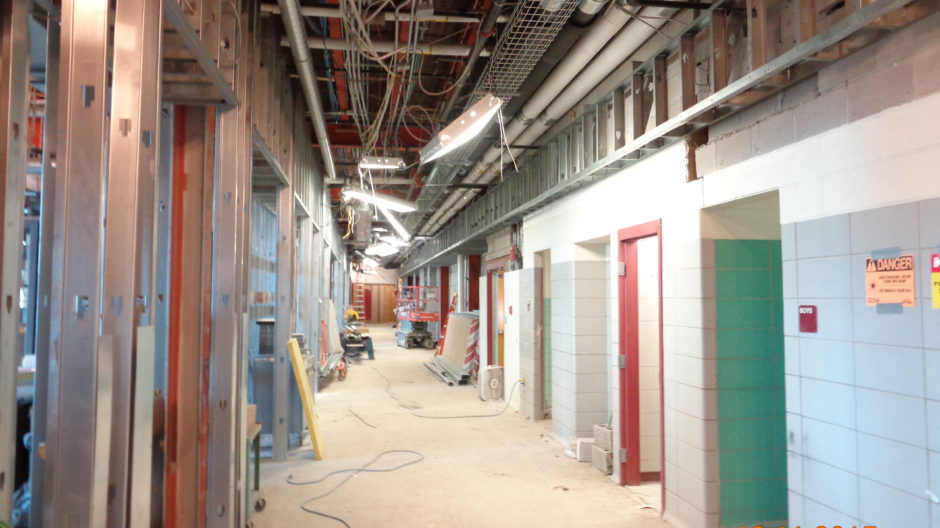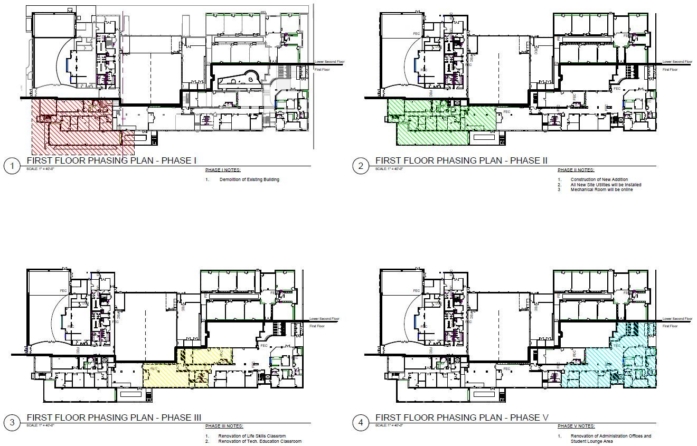How to Maintain Continuous Occupancy During School Renovations

Adaptive spaces, environmental safeguards, and a collaborative approach can connect students and their families to a unique process that incorporates everything that they are learning.
One of the reasons often noted in favor of constructing a new school is the difficult logistics required to maintain operations while renovating any existing school building. There is no question that maintaining continuous occupancy while renovating takes an extra level of planning, safety and communication, but it is entirely achievable. It may even be necessary, especially for school districts looking at a trend of declining enrollment. But how does it work when school is in session?
SWING SPACE
A key component is the ability to develop or use some space within the District that is currently underutilized. It might be possible to increase the utilization of the facility in question, freeing up approximately 25% of the instructional spaces for phased renovation. Leasing temporary classrooms for a year or two for an entire department can help. Housing an entire grade in another facility as a small school within a school can work too.
If the project includes an addition, constructing it in an early phase can create the necessary swing space.
COMMON SPACES
Another component is the use of open spaces as temporary learning environments. Administrative offices can be moved to temporary office trailers. Music and Art programs can be run from carts for the renovation period. Physical education can be accommodated by using a combination of outdoor athletic fields and cafeteria spaces. Learning resources (libraries) can turn to more portable media, and Student assemblies can be done through some applied technology for the renovation period. Food service can be outsourced from another kitchen or even commercial catering services.
Normally, these common spaces are scheduled for their renovation during summer breaks. It helps if the school year can be adjusted so that the spaces can be available earlier in the spring and later in the fall (short durations without the common facility on either end of the summer.) Material stockpiling and preparatory work can start while the facilities are still in use, and long days, long weeks, or multiple shifts can shorten the construction duration.
SAFETY
Interim internal circulation routes must be designed into the renovation to isolate students from construction activities and eliminate dust, noise, and other contaminates. Transitions from one finished area to the beginning of renovation of a new area, must be tightly scheduled for holiday vacancies. Progress must be tightly monitored with every slippage covered by a recovery schedule. Heavy penalties for delays and careful attention to submittals, lead times, material deliveries, and adequate manpower will assure that the phased renovations stays on schedule. Temporary corridors and entrances must be fully equipped with accessible features; smoke, fire, and security detection and alarms; safe levels of lighting and adequate restroom facilities.
MECHANICAL, ELECTRICAL, PLUMBING, AND TECHNOLOGY
In a project intended for continuous occupancy, the current systems will need to stay in place for some duration of time. Otherwise new boilers, electrical service, plumbing service and hot water must be constructed first (perhaps in a new addition) and then connected as needed. Wireless technology can become a reasonable temporary service. Long lead times for major equipment need to be anticipated and planned for and may even be purchased directly in advance of actual construction activities.
IMPACT UPON LEARNING
There is no evidence that being in the middle of a construction project is harmful to learning. If approached thoughtfully, it is a remarkable collaborative and creative learning experience. Almost all subject areas can be focused on the real-world building process going on around them. Some care must be taken with respect to noise during testing weeks, but almost everything else is a learning opportunity that connects the students to the real world. A world we are preparing them to be a part of someday. It is a once in a generation chance to connect the students and their families to a unique process that incorporates science, technology, engineering, art, and math (STEAM).
No doubt that there are inconveniences, and everyone will be glad when it is over (and appreciative of their new school). At least one generation of teachers and students will have a strong appreciation of the process from conception through implementation.
WARNING
Maintaining continuous occupancy is NOT something that can be elected after the design is complete, and the Construction team is on board. The final design, as well as the phasing plan must be integrated as a part of the design and engineering of all the systems and building components. With some forethought, it can save a District millions of dollars in the utilization of site work and structural bones of an older building without the costs of setting up a temporary school somewhere else.

Example Phasing Plan designed to facilitate continuous occupancy through appropriate sequencing, minimal moves, accessible routes, separation of students and staff from contractors, continuous monitoring, and acceptable noise levels

